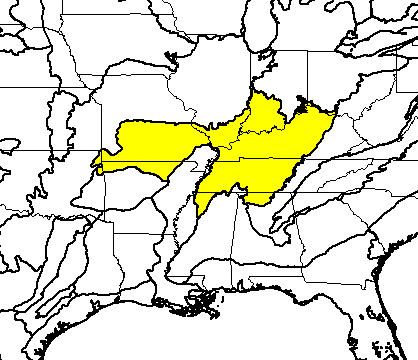
Radnor Lake State Natural Area, Nashville, Tennessee (c) 2003 Steven J. Baskauf
Bioimages home (click on an image to enlarge)
view
this page in its intended navigation context
Central U.S. Hardwood Forests
(WWF
ecoregion NA0404)

Radnor Lake State Natural Area, Nashville, Tennessee
(c) 2003 Steven J. Baskauf

Source of bioregions data:
Olson, D. M. and
E. Dinerstein. The Global 200: Priority ecoregions for global conservation. (PDF
file) Annals of the Missouri Botanical Garden 89:125-126.
Distinctiveness (1=highest,4=lowest): 2
(regionally outstanding)
Among the richest in North America for herbaceous plants and shrubs, with less
diverse tree flora.*
Conservation Status (1=most endangered, 5=most
intact): 2 (endangered)
Only about 1% intact habitat in small, fragmented blocks. Threatened by
urbanization, invasive species, and fire suppression.*
 Quercus
alba
Quercus
alba Quercus
rubra
Quercus
rubra Quercus
velutina
Quercus
velutina Carya
cordiformis
Carya
cordiformis Carya
ovata
Carya
ovata Cornus
florida
Cornus
florida Sassafras
albidum
Sassafras
albidum Carpinus
caroliniana
Carpinus
caroliniana Ulmus
americana
Ulmus
americana Liriodendron
tulipifera
Liriodendron
tulipifera Liquidambar
styraciflua
Liquidambar
styracifluaComprehensive list of common Middle Tennessee herbaceous plants
Associated habitats
In this ecoregion, differences in slope and aspect (e.g. north vs. south
facing slopes) produce varying moisture conditions which are favorable to
particular plant species. In middle Tennessee, northern Alabama, and parts
of Kentucky, limestone areas with shallow soil produce a unique habitat known as
cedar glades.


bottomland hardwood forest, Cache River State Natural Area, southern
Illinois (c) 2002 Steven J. Baskauf
hires
hires
Typical woody species: Acer
rubrum (red maple), Acer
saccharinum


mesic slope forest (left: March, right: May) , Radnor Lake State Natural
Area, Davidson Co., middle Tennessee (c) 2003 Steven J. Baskauf
hires
hires
Typical woody species: Acer
saccharum


dry ridge, Wildcat Bluffs, Cache River State Natural Area, southern
Illinois (c) 2002 Steven J. Baskauf
hires
hires
Typical woody species: Carya
glabra




cedar glade, far left: Cedar glades are natural openings in the
forest - usually surrounded by Juniperus
virginiana
Typical woody species: Carya carolinae-septentrionalis (southern shagbark hickory), Forestiera ligustrina (upland
swamp-privet or shrub swamp-privet), Fraxinus
quadrangulata
List of typical cedar glade flowering plant species
* Ricketts, T.H., E. Dinerstein, D.M. Olson, C.J. Loucks, et al. (1999) Terrestrial Ecoregions of North America: A Conservation Assessment. World Wildlife Fund - United States and Canada. Island Press, Washington, D.C. pp. 190-191.
Except as noted, images copyright 2002-2004 Steve Baskauf - Terms of use